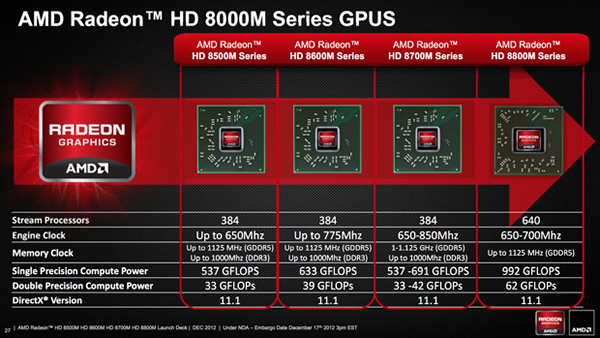AMD's Radeon HD 8000M family was officially announced last month, but with CES now underway the company has taken the chance to inform us that their latest generation mobile GPUs are now shipping in products from Asus and Samsung, with Lenovo and other OEMs joining the party soon.
AMD Radeon HD 8000M Series
This is AMD's first series of mobile graphics chips based on the Graphics Core Next architecture. As previously reported, the new parts are built on a 28nm process and feature full Direct X 11.1 support as well as ZeroCore and Enduro to scale down power usage when possible based on graphics demand.

The lineup includes 8500M models (384 stream processors, 650/1125MHz), 8600M series models (384 stream processors, 725/1125MHz), 8700 series models (384 stream processors, 850/1125MHz) and a higher-end 8700M series which boasts 640 stream processors, 700MHz core and exclusively uses GDDR5.
Desktop rebadge frenzy: Radeon HD 8000 Series for OEMs
On the desktop side AMD also announced the availability of AMD HD 8000 series graphics cards, but these remain exclusive to OEMs for now and are essentially rebadges of the entire Radeon HD 7000 family from top to bottom. Official specs for as many as nine different graphics cards were published by AMD, including the flagship Radeon HD 8970, a rebadge of the Radeon HD 7970 Gigahertz Edition with 2,048 stream processors, a core clock of 1GHz, and 3GB of GDDR5 memory clocked at 6GHz on a 384-bit bus.
Upcoming APUs: Kabini, Richland, Kaveri, Temash
AMD also discussed a range of new Accelerated Processing Units (APUs) that are set to arrive later this year. The two highlights were codenamed Temash and Kabini, two products that the company is touting as its first true system-on-chip APUs, and quad-core x86 parts at that. Kabini is designed to take on Intel on the ultra-thin notebook segment, with up to 50% more compute performance than current-generation Brazos 2.0, while Temash replaces Hondo as AMD's tablet and hybrid APU with double the graphics performance.
Moreover, Richland is aimed at more traditional laptops and desktops, with a claimed performance boost of 20% to 40% over the current generation of A-Series products. AMD said that Richland APUs are already shipping to OEMs and announced that systems built around this chip will come bundled with gesture- and facial-recognition software to "expand and enhance consumers' user experiences".
Lastly, the follow up to Richland will be arriving in the second half of 2013, with the 28nm Kaveri APU boosting performance further and adding new heterogeneous systems architecture (HSA) improvements.